![]()
![]()
![]()
Use LEFT and RIGHT arrow keys to navigate between flashcards;
Use UP and DOWN arrow keys to flip the card;
H to show hint;
A reads text to speech;
60 Cards in this Set
- Front
- Back
|
What are the possible causes for cataract
|
1. Uveitis, RP
2. corticosteroids 3. Diabetes, myotonic dystrophy, atopic dermatitis 4. Down syndrome 5. Many are idiopathic |
|
|
Lens development
1. 3rd wk 2. 6th wk 3. 7th mon |
1. 3rd wk
● differentiate from surface ECTODERM 2. 6th wk ● separated from ectoderm ● form Lens Vesicle ● develop Embryonic lens nucleus 3. 7th mon ● "Tunica vasculosa lentis (hyaloid) disappears 3. 7th mon |
|
|
Lens anterior epithelium
1. in which region is responsible for production of ner fibers |
Epithelial region near the equator
|
|
|
Lens
-Zone of discontinuity |
Alternating light & dark bands/ lines seen with SLE ( Most visible at 30-40age)
-different indices of refraction |
|
|
Lens
-zone of disjunction |
Relatively "Clear" or "Darker" region seen under the Ant. lens capsure
-composed of the NEWEST, YOUNGEST fibers |
|
|
Time of development
1. Embryonic nucleus 2. Fetal nucleus 3. Juvenile nucleus (Infantile) 4. Adult nucleus 5. Cortex |
1. Embryonic nucleus- 7 wk
2. Fetal nucleus- 8 mon 3. Juvenile nucleus (Infantile)- early~mid teens 4. Adult nucleus-late teens to mid-20s 5. Cortex- mid 20s throughout life |
|
|
What are the anatomical regions of lens that present at birth
|
embryonic nucleus
fetal nucleus Y suture capsule |
|
|
Name the clinical features of the lens from Center to Anterior capsule
|
Embryonic nucleus
Fetal nucleus Y suture Juvenile nucleus (infantile) Adult nucleus Cortex "Zone of disjunction" Capsule |
|
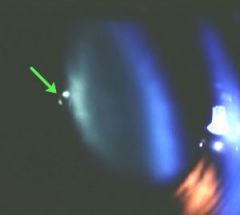
What lens anomalies is this?
|
Mittendorf dot
● remnant of hyaloid system (small, white, circular) ● at INF+NAL on Post. lens capsure ● not clinically impt to affect vision |
|
|
Vogt's Reflex line
|
Remnant of hyaloid
Faint, gray thing line Reversed C-shaped line Post. lens surface Not clinically impt to affect vision |
|
|
Coloboma
1. definition 2. appearance |
1. Definition
● incomlete lens development 2. appearance ● Notch in the edge |
|
|
Define "Ectopia lentis"
|
aka "Lens luxation"
Marfan's: UPWARD Homocystinuria: DOWNWARD ● DO NOT dilate if lens is loose, can fall into AC --> pupillary block glaucoma |
|
|
Lenticonus
1. usually one eye or both eye 2. Alport's syndrome 3. Lowe's syndrome 4. vision problem |
1. usually UNILATERAL
2. Alport's (deafness, renal failure, white retinal flecks): ANT. con 3. Lowe's ( glaucoma, mental ret.): POST. con 4. Vision ● Irregular astigmatism ● myopia ● decrease acuity |
|
|
Define "Spherophakia" , associated with
|
●lens with a SHORT radius of curvature
●associated with microphakia, extreme myopia, tend to subluxate and dislocate anteriorly ●associated w/ " Marchesani syndrome" (short stature, stubby fingers and toes) |
|
|
Define "Congenital Cataract"
|
present AT birth, or within 3 month after birth
|
|
|
Congenital Cataract
1. Cause |
1. Cause
● MOST are Idiopathic ● 25% are inherited and part of a syndrome 2. BILATERAL = inherited = autosomal Dominant |
|
|
Cataractogenic agents for Congenital Cataracts
|
●Ionizing radiation- risk at 1st trimester
●Drugs- risk at 1st trimester (steroids, antibiotics) ●Metabolic disease of mother- diabetes, hypocalcaemia ●Maternal malnutrition-amino acid, niacin, thiamine, riboflavin deficiencies ●Intrauterine infection- toxoplasmosis, rubella, CMV, syphilis |
|
|
Review Types of Congenital Cataracts in Esther's final study guide on p. 35
|
Embryonic nuclear cataract
cataracta centralis pulveralenta etc |
|
|
Congenital cataracts that are Bilateral
|
Embryonic nuclear cataract-autosomal dominant
Sutural cataract- X-lnked Zonulae-Lamellar cataract-abnormal Ca metabolism |
|
|
Stellate/ stalagmite/coraliform
|
放射狀
|
|
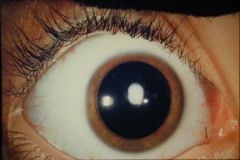
what type of congenital cataract is this?
|
Anterior polar cataract
●cotton-ball like opacity ●ANT. sub-capsule ●made of hyaline, Ca, cholesterol, degenerating lens fibers ● sharp edge ● associated w/ "Persistent pupillary membrane" |
|
|
Effect on vision:
ANT. polar vs Post. polar cataract |
Ant little visual decrease
Post. GREATER vision decrease b/c closer to nodal point |
|
|
Most common congenital cataract is
|
Zonule /Lamellar
|
|
|
Which congenital cataract accounts for 30% of all cases
|
Sutural cataract
|
|
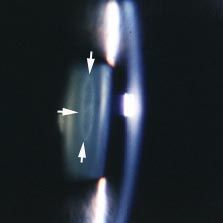
What type of congenital cataract is it?
|
Zonular-lamellar cataract
● bilateral ●circular zone with clear center surrounding nucleus ● associated with ABNORMAL Ca++ metabolism |
|
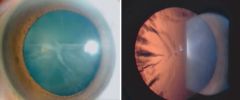
what type of cataract is it?
|
Total/Diffuse cataract
● inherited ● all lens fibers affected ● seen as white calcified mass w/in pupil ● capsule shrinkage |
|
|
Age-related "Senile' Cataract
1. Prevalence 2. Risk factors |
1. Prevalence-Most common
2. Risk factors ● aging ● smoking ● steroids ● diabetes ● nutrional factors ● UV |
|
|
Define "Intumescence"
|
swelling of the lens
|
|
|
Cortical Cataract
1. Cause 2. Incidence 3. Sx 4. Clinical signs |
1. Cause
● increase permeability of capsule --> liquefaction of lens fibers --> breakdown and coagulation of fiber proteins --> opacification 2. Incidence ● 3% at age 40-55 ●30% > 75 age 3. Sx ● glare ● dec acuity ● dec contrast ● monocular diplopia ● slight inc in hyperopic shift 4. Clinical signs ● vacuole ● water clefts ● spokes ● lamellar separation ● diffuse opacification ● morgagnian ● phacotoxic-phacoanaphylactica ● phacomorphic glaucoma |
|
|
Define "Vacuoles"
|
circular pocket of fluid
|
|
|
Define "Spoke"
|
wedge-shaped opacity
|
|
|
Mature vs Hypermature cataract
|
Mature: entire cortex is hazy and more gray
Hypermature: entire cortex is comlpletely opaque and white |
|
|
Define "Morgagnian" cataract
|
solid HARD nucleus floats in "white" liquefied fluid cortex
.Usually sinks inferiorly. |
|
|
Define "phacotoxic"
|
lens induced uveitis
|
|
|
Define " phacolytic glaucoma"
|
lens induced
proteins and macrophages in TM impede AH outflow --> increase IOP |
|
|
Define "phacomorphic glaucoma"
|
swelling of lens cortex --> shallows the AC --> Secondary angle closure glaucoma
|
|
|
Cortical cataract vs Nuclear cataract
|
Cortical cataract
● liquefaction of lens fiber ● SOFT cataract ● hyperopic shift Nuclear cataract ● hardening of lens fibers ● HARD cataract ● myopic shift (-0.5~15D) |
|
|
Color appearance in nuclear cataract is due to (2)
|
modification of proteins
formation off "Urochrome pigment" Early stage: yellow-gold Later stage: dark brown |
|
|
Most common age-related cataract is
|
Nuclear sclerosis (55% > 75 age)
|
|
|
Nuclear cataract
1. sx 2. clinical signs |
1. Sx
● Distance blur ● Improved near vision ("Second sight") ● Myopic shift ● loss of color discrimination ● Diplopia 2. Clinical signs ● yellowing of the lens and loss of central lens lines |
|
|
2 types of posterior subcapsular cataract
|
1. Cupuliform (More common)
● cup shape ● w/ aging, steroids use, myotonic dystrophy, atopic dermatitis. 2. Complicated (Less common) ● w/ longstanding intraocular disease ● RP, myopic degeneration, posterior uveitis |
|
|
What is the LEAST common age-related cataract
|
Posterior subcapsular cataract
(11% >75) |
|
|
From most common to least common age-related cataract
|
Nuclear > Cortical > Post. subcapsular
|
|
|
Posterior subcapsular cataract
1. Sx 2. Clinical signs (Cupuliform vs Complicated) |
1. Sx
● decrease in vision (esp when pupils are small) ● in dim, can see around the opacity 2. Clinical signs (Cupuliform vs Complicated) ● Opacity stays in subcapsular region only in Cupuliform while opacity spread to adjacent cortex in Complicated one. ● Faint iridescence of B&G in Cupuliform while Polychromatic colors of B&G&R in Complicated cataract. |
|
|
If seeing Unilateral cataract, what is the possible cause
|
Trauma
|
|
|
Traumatic cataract generally shows what type of pattern
|
Stellate (star)
Rosette ( petals of rose) |
|
|
Pseudocataracts include
|
1. Vossius ring
2. Epicapsular stars 3. Pseudoexfoliation |
|
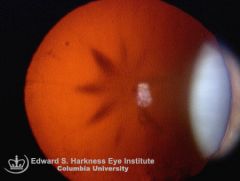
If this is an unilateral cataract, what is the most likely type
|
Traumatic cataract ( due to stellate shape)
|
|
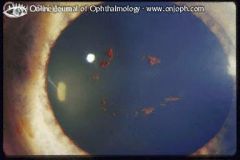
Identify
|
Vossius ring
● imprint of pigment from iris on ant. lens capsure ● 2' to blunt trauma and compression of ant. seg |
|
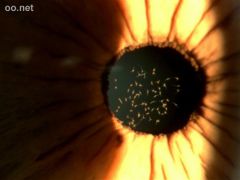
Identify
|
Epicapsular stars
● remnant of hyaloid system ● in high mag, look like little starfish ● pseudocataract |
|
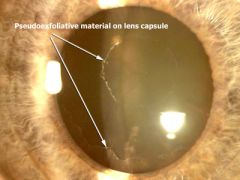
identify
|
Pseudoexfoliation
● amyloid like fiber abnormality ● risk of developing glaucoma ● Don't be mistaken as cataract |
|
|
Define "Cerulean"
|
Bluish punctate opacities w/in adult nucleus or cortex
|
|
|
Diabetic cataract
1. clinical signs |
1. signs
● White snowflake-like opacity w/in Ant/Post. subcapsular regions ● RAPID progression |
|
|
Define "Glaucomflechen"
|
grayish flecks in Ant. subcapsular region, asso w/ episodes of RAPID increase in IOP (>50 mmHg)
|
|
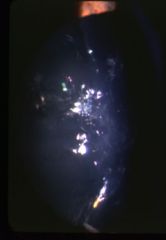
identify
|
Crystalline cataract
● "X'mas tree" cataract ● very colorful ● usually unilateral |
|
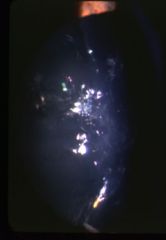
identify
|
Crystalline cataract
● "X'mas tree" cataract ● very colorful ● usually unilateral |
|
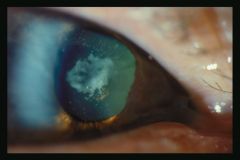
identify
|
Glaucomflechen
● gray flecks in Ant. subcapsular region |
|
|
Intracapsular cataract extraction
|
remove entire lens + capsule
|
|
|
Extracapsular cataract extraction
|
suture-less clear corneal incisions and intraocular lens implants (IOL)
|
|
|
Surgical ocular complications of Cataract surgery
|
1. Corneal edema ( pseudophakic bullous keratopathy)
2. Infection (unusual) 3. Prolonged inflammation ● UGH syndrome ● U= Uveitis ● G= Glaucoma ● H= Hyphemas 4. Iris prolapse 5. Iris capture of IOL (not common) 6. Iris atrophy (due to rubbing) 7. IOL decentration ( see halos, aberrations) 8. Posterior capsule tear (lead to post. seg inflammation) 9. Retained cortical material 10. Retinal detachment 11. 2' mb/ Elschnig's pearls ( opacification of post. capsule) |

